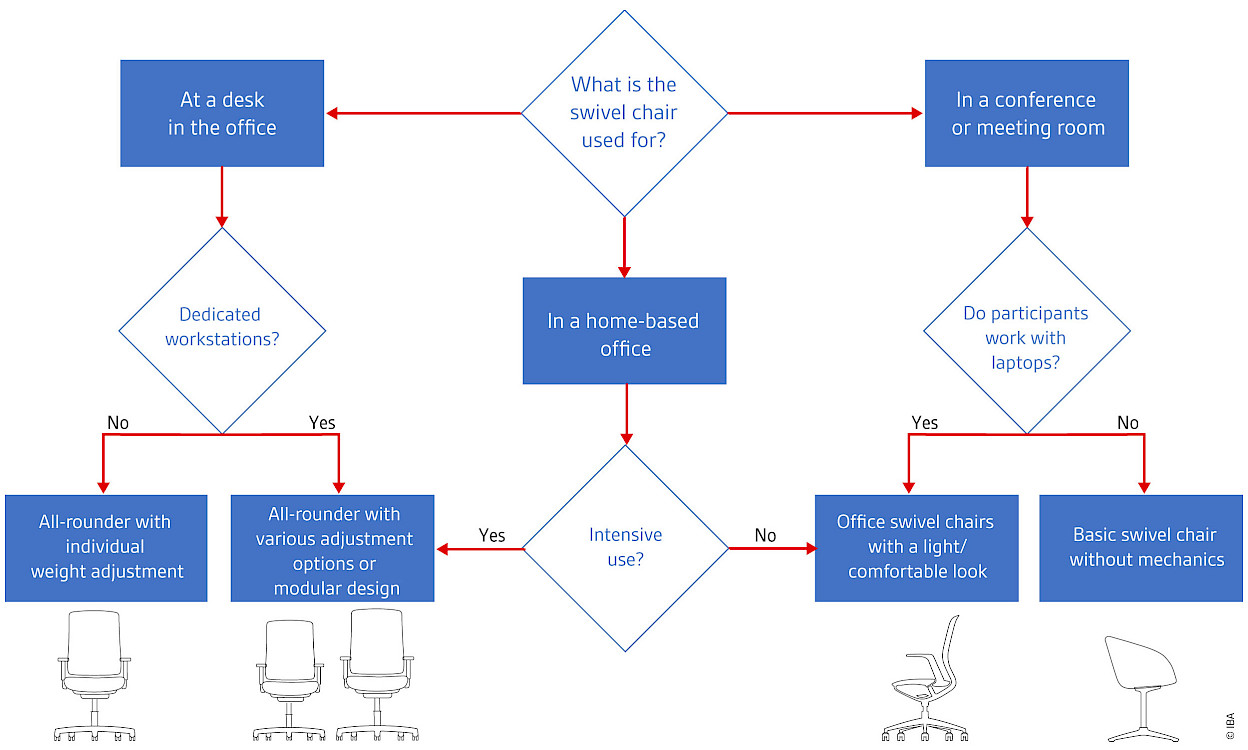The range of office swivel chairs is vast – and so too is the variety of possible features and functions. This opens up entirely new possibilities. The following overview is designed to make selection easier.
The recommendations are based on the guidelines that apply to Quality Office certification.

The All-Rounders

The most important place for swivel chairs is at the desk. As people often sit there for several hours at a stretch, seating comfort, optimal back support in different sitting positions, and a good fit to the user’s body size are essential. Detailed information can be found under Quality Criteria for Office Chairs.
Beyond these basic functions, a few decisions need to be made when choosing a chair for the office:
AS INDIVIDUAL AS POSSIBLE OR SUITABLE FOR EVERYONE?
Whether certain features make sense depends largely on whether a chair is used by one person only or by several people. At a permanently assigned workstation, individual adjustment options are advantageous. In desk-sharing environments, however, it is usually better to opt for a well-equipped all-rounder that works for most users, ideally with automatic weight adjustment. The reason: most employees only change the seat height when taking over a workstation. Other individual settings made by colleagues are usually left in place, even if they are unsuitable. Depending on usage, either a highly adjustable model or a reliable all-rounder is the better choice.
MESH, PLASTIC OR UPHOLSTERY?
For the seat, the answer is clear: upholstery is the better long-term option. The padding should not be too thin, and the foam should not be too soft. For the backrest, it comes down to personal preference – the crucial point is good lumbar support.
2D OR 3D MECHANISM?
The basis of good sitting is the synchronised mechanism (or a comparable solution), where both the backrest and the seat follow the body’s movement when leaning back. This function is a must for all regularly used workstations.
3D mechanisms also allow lateral movements. Studies show that 3D chairs have a positive long-term effect on user wellbeing. There are several technical solutions for this, but it is important that the chair never feels unstable. As a rule: better a good 2D model than a poor 3D chair.
GAMING CHAIR OR OFFICE SWIVEL CHAIR?
The answer here is clear: for office use – and also for frequently used home office workstations – it must be an office swivel chair. Gaming chairs are designed for comfort with minimal movement. In the office, however, the focus must be on encouraging movement and frequent changes of posture.
Swivel chairs manufactured in line with the relevant European standards are suitable for continuous use by individuals weighing up to 110 kg. Many manufacturers now offer models that go beyond this limit – it is worth asking.
The Homely Ones

Alongside classic office chairs, many manufacturers also offer another group of swivel chairs. These dispense with complex mechanisms but still allow health-promoting dynamic sitting – in simpler form.
These chairs are particularly suitable for:
HOME OFFICE
Thanks to their lighter appearance and lower price (compared with top-level office chairs), they are ideal for home office workstations that are used occasionally rather than permanently. As they generally offer only limited adjustment options, it is important to test whether they meet individual needs.
MEETING AND TRAINING AREAS
If participants in meetings frequently work with laptops or tablets, this argues in favour of replacing four-legged chairs, skid-base chairs or cantilever chairs with swivel chairs. The reason: most frame-based chairs are optimised for a slightly reclined posture and are unsuitable for upright laptop use. When choosing swivel chairs for meeting or training areas, particular attention should be paid to the stability of the adjustment elements, as unconscious fiddling with them can cause additional wear.
European standards for office chairs cover not only safety and durability but also dimensions, based on the body measurements of women and men across the EU and the UK. For example, office swivel chairs conforming to DIN EN 1335–1 are the right size for more than 90% of workers in Europe. Nevertheless, it may be worth considering smaller or larger models.
The Simple Ones Without Mechanisms

Because they often still offer seat height adjustment and swivel function, these models allow more dynamic sitting than four-legged, skid-base or cantilever chairs.
CASTORS, GLIDES OR DISC BASE?
The more dynamic the use, the more important it is for the chair to move easily – in which case castors are the best choice. Disc bases, on the other hand, are suitable only where chairs should not be moved, for example in bar-like areas. A good compromise is models with a star base on glides.
WITH OR WITHOUT ARMRESTS?
The ability to rest the arms almost automatically encourages a relaxed sitting posture. Armrests – whether as separate elements or integrated into a shell seat (see illustration) – should only be omitted if every centimetre of seat width is needed.





